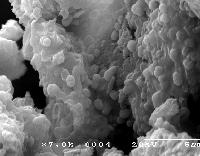
Abstract:
The bacteria {\it Pseudomonas Aeruginosa} use the size and density of their colonies to regulate the production of a large variety of substances, including toxins. This phenomenon, called quorum sensing, apparently enables colonies to grow to sufficient size undetected by the immune system of the host organism. In this paper, we present a mathematical model of quorum sensing in {\it P. Aeruginosa} that is based on the known biochemistry of regulation of the autoinducer that is crucial to this signalling mechanism. Using this model we show that quorum sensing works because of a biochemical switch between two stable steady solutions, one with low levels of autoinducer and one with high levels of autoinducer.

To see a movie demonstrating the bistability of this system click here.

See a simulation movie of a growing gel. This gel converts nutrient into gel and then expands because of swelling pressure. The reality is that a typical biofilm does not begin to make gel until the size of the community is large enough. The switch to turn on gel production is called quorum sensing and is mediated by a chemical called the autoinducer. In this simulation movie is shown the growth of a colony with quorum sensing. Notice that the colony starts out quite dense, but when the gel production begins, the density of the colony drops substantially. There are mutants that cannot make the autoinducer (the signally molecule for quorum sensing. In this simulation movie is shown what happens to a colony that cannot make autoinducer. In this simulation movie, there is no bacterial growth, but the bacteria make gel which enables the bacteria to move.